STEAM LAWN MOWERS IN GREAT BRITAIN
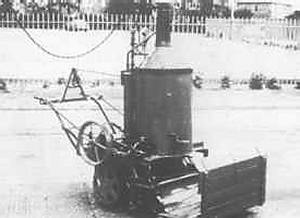 |
| Left: The Leyland Steam lawnmower: late 1890s
The Leyland steam mower was one of the first motorised lawn mowers; produced for just a few years at the end of the 19th and the start of the 20th centuries. The earliest motorized lawn mowers were made around 1896 by a newly formed Lancashire Steam Motor Company in the town of Leyland, England. Shortly after, the company name was changed to Leyland Motors and later became British Leyland, makers of cars such as the Jaguar, Rover, Land Rover and the original Mini car. The steam mower was produced for just a few short years before Leyland Motors moved into producing petrol-powered wagons.
The mower was, judging from the height of the handlebars, about six feet tall. It had a vertical boiler mounted above the mower chassis, and was powered by a small two-cylinder steam engine with a sizable flywheel and spur gear transmission to the rear driving roller. (completely unguarded, as was not uncommon at the time)
The boiler was oil-fired, presumably to reduce the workload of the driver. Stoking and steering at the same time would have made an uneasy combination.
|
Cutting the grass on large areas such as playing fields or country-house parks was a big job, beyond the power of any reasonable number of men pushing hand lawn mowers. It had traditionally been done by a row of men with scythes, but as labour costs rose, and the neat cut available from the cylinder mower became considered mandatory, other methods were adopted. Big multi-cylinder mowers for this work were usually drawn by horses or ponies.
Although steam had been established as the prime source of power for decades (and in fact was already meeting the first tentative challenges from internal-combustion engines) it was not until 1893 that the first practical steam lawn mower appeared. It was designed by James Sumner of Leyland, Lancashire. Very few appear to have been made, and there is apparently only one surviving example, safely preserved at the University of Reading.
 |
| Left: The Leyland Steam lawnmower at work
The Leyland mower could be operated by one person, and removed the need to house and feed a draught animal that might have no other work to do. However, that one person needed to be skilled in the operation of steam machinery, which can be lethally unforgiving of incapacity or inattention, and would have expected appropriate wages. The boiler would have required a regular supply of water. The mower was also inevitably expensive to buy, and required careful maintenance, like any machine that included a steam boiler.
|
Sumner renamed his company the Leyland Steam Motor Company in 1895, and the business in time went on to become the motor-car manufacturer British Leyland.
Competing steam mowers were marketed shortly after the Leyland, by Alexander Shanks of Arbroath, and Thomas Green of Leeds; none of the machines was a commercial success. The introduction of internal-combustion engines at the end of the 19th century gave a much more practical prime mover; Ransomes of Ipswich produced its first petrol engined mower in 1902, and there was clearly no future for steam mowing.
Examples of steam lawnmowers are in very short supply; apart from an example at the University of Reading, no others are known. There is a modern replica of the Leyland steam mower in a museum in Coventry, made by British Leyland apprentices in the 1950's, based on an original belonging to Repton College, with the original engine re-built.
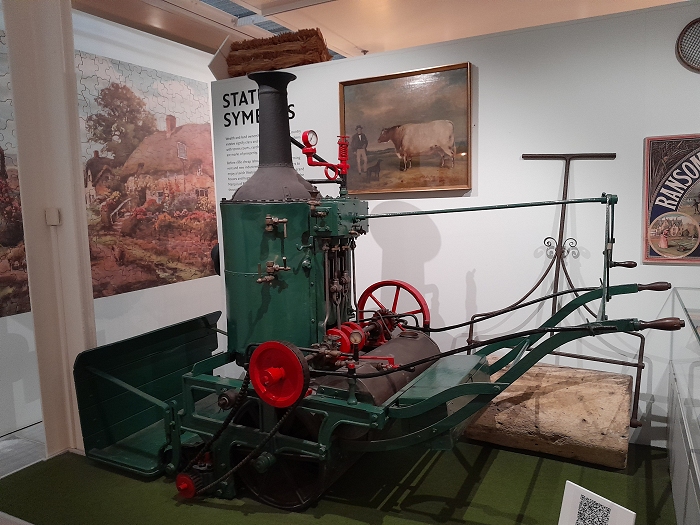 |
| Left: Leyland steam mower
This mower is in the Museum of English Rural Life at Reading. I am told this is not the replica pictured just above, but an original example.
Note the differences in the water-level gauge on the side of the boiler.
Grateful thanks to J Palterman for providing this image.
|

STEAM LAWN MOWERS IN THE USA
 |
| Left: The Coldwell Steam lawnmower
The Coldwell steam estate lawn mower and roller units were built in Newburgh, New York. This example carries two patent dates - March 5, 1901 and August 19, 1902. The boiler is a liquid fuel fired vertical-firetube type jacketed in copper with a copper smoke cone and chimney, which supplies a small vertical double simple-expansion steam engine, (visible at far left) approximately 2" bore x 4" stroke, with two bar guides, link reverse and crosshead driven boiler feed pumps.
Engine and boiler are mounted between steel arched frames which also carry a copper twin tank for water and fuel, with the driver's seat on top. Roller chains (missing in this picture) drive a jackshaft and separate drives go to the mowing reel and the large under-roll; a small outrigger roll is provided at the engine (rear) end of the frame. Forward movement is to the right of the picture. Steering is by tiller in this version. The steam engine has a copper steam-jacket, and ball-bearing big-ends, and is of steam automobile style. The mowing reel cuts a 40" swath. At one time Coldwell steam mowers were used on the White House lawns.
|
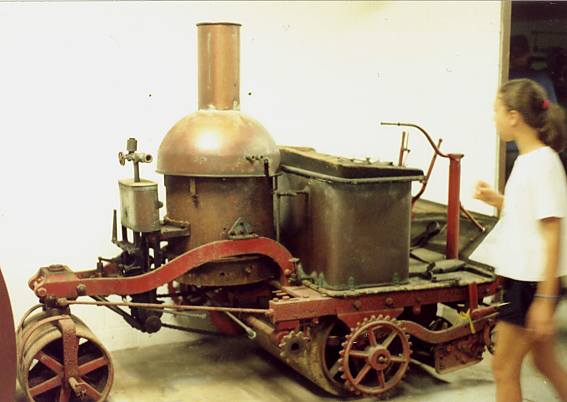 |
| Left: The Coldwell Steam lawnmower
Another view of the Coldwell steam estate lawn mower, showing the rear section.
Note that the drive-chain to the middle roller is missing. The boiler also appears to have a larger domed section than shown in the advert below; probably the lagging has been removed at some point.
As of 2001, the mower in the picture remained unrestored, but restoration occurred in 2016.
Location: Rough and Tumble Engineers, Kinzers PA, USA
Thanks to Jim Ricci for informing me about the restoration. He has written a book on lawnmowers, called Hand, Horse, and Motor: The Development of the Lawn Mower Industry in the United States. See here.
|
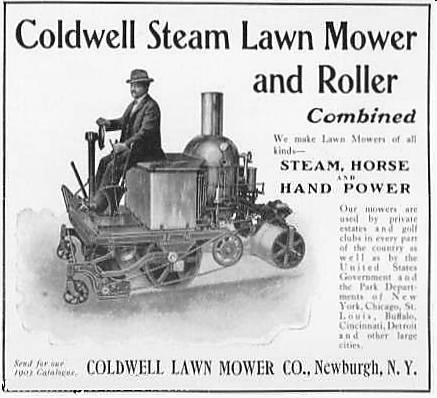 |
| Left: Coldwell Steam lawnmower ad in 1903
This version shows steering by a vertical wheel rather than a tiller.
The picture clearly implies that the Coldwell was suitable for one-man operation. It looks as if the driver might be able to read the pressure gauge by turning round, but it is not clear if he can see any indication of boiler water level.
The men behind the machine appear to be William H Coldwell, Harry T Coldwell,and Thomas Coldwell. The first two chaps took out a number of mower patents, for example No. 796,811 which was issued in August 1905, but the March 1901 patent referred to above (No. 669,436) was taken out by Thomas alone, and the August 1902 patent (No. 707,304) by Thomas and William.
The 1901 patent refers only to a means of bearing adjustment, but the 1902 patent explicitly covers a steam mower and has a drawing very like the actual machine as shown here.
|
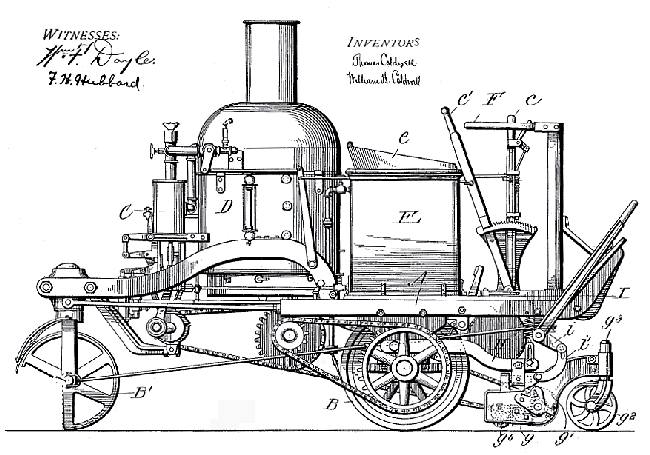 |
| Left: One of the diagrams from the Coldwell patent of 1902
This version shows tiller steering.
The drawing is clearly derived from the original machine. The vertical steam engine C can be seen to the right of the boiler D.
It appears that the driver is going to have to be something of a contortionist if he is going to keep an eye on the pressure gauge and the all-important water-level gauge without leaving his seat.
|
 |
| Left: A Coldwell mower in use: 190?
This version appears to have tiller steering.
The mower is apparently in use but there is no smoke coming from the funnel, so it maybe not.
|
 |
| Left: A comtemporary photograph of a Coldwell mower
This version has a vertical wheel for steering. It looks very much like the advert above, and may have been the source of an engraving for printing.
Taken from a glass plate photgraph.
Many thanks to Alan Crawford for the image.
|



















